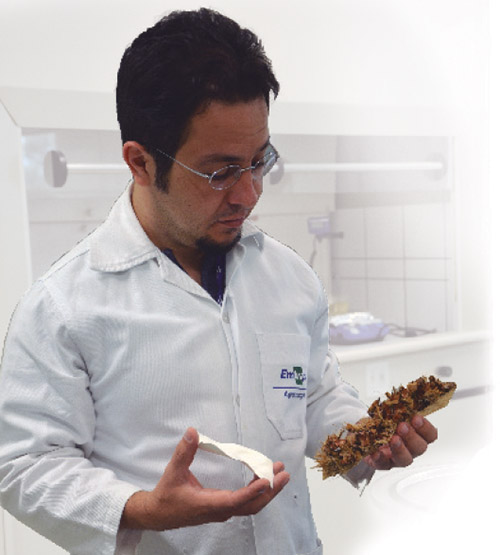African oil palm nanofibers
15/07/15
|
Nanotechnology
African oil palm nanofibers
They are crystal clear and have high mechanical strength. The challenge is to increase the scale and efficiency, and also test their application as reinforcements for other materials
Unlike the traditional tale of the scientist depicted as a researcher who spends a great deal of time alone in the laboratory to "conquer and fix" the world, daily routine tends to be much more stimulating. It is full of surprises and conflicts. For researcher Leonardo Fonseca Valadares, from Embrapa Agroenergy, the laboratory routine is versatile, motivated by challenges and long-term learning. "The routine is not boring. The work has several stages: one day you are planning, the other executing, then dealing with data, and after that arguing about the results. When a conclusion is reached, new ideas arise to plan new experiments and new projects. It is a very dynamic process".
Leonardo is the leader of a research that began in April 2012 with the aim of extracting cellulose nanofibers of African oil palm bunches. African oil palm (Elaeis guineensis) is a plant with the potential to integrate the biodiesel production chain, thanks to its high productivity. It can yield up to six tons of oil per hectare. Soy, for example, generates between 500 and 600 kilos in the same space. However, for each ton of oil, 1.1 ton of empty bunches remains, which can be used for soil fertilization. The goal is to obtain greater added value from the crop using this material.
In the laboratory, the work begins with the extraction of cellulose by purification processes, which yield a material very similar to paper. The next step is the extraction of nanofibers. "The nanofibers of empty bunches have nanometric thickness. We use microscopes to see and characterize them", Leonardo explains.
It is already known that the nanofibers of African oil palm bunches are crystal clear and have high mechanical strength, comparable to certain metals. Embrapa Agroenergy wants to test it as reinforcement for natural rubber. The difficulty has been the low amount of nanofibers obtained and a sequence of extractions that is necessary. First, the cellulose, which is a fraction of the material itself, is cleansed. Then, only the nanofibers are separated, yielding an even smaller portion. "We had expected to achieve a larger quantity, but we realized it is not going to be easy".
Increasing the scale and the yield is the next stage of the study that, in addition to continuing in the laboratory, is also going to be developed in Embrapa Agroenergy's pilot plant area. Testing the application of nanofibers as reinforcement for other materials besides natural rubber is also in the team's plans.
Optimizing the process to ensure that the conditions and costs are compatible with industrial reality is the challenge to be overcome if the intention is to insert the product in the market. Leonardo explains that, in the early stages of development, in the laboratory, the best reagents and supplies are used, in the amount needed to reach the result. Then the studies to adjust the processes begin so as to reach the appropriate scale, conditions, and costs.
For the researcher, the achievements go beyond scientific results. They are also in the adaptation of laboratories, in the contact with other researchers, personal self-development, observation of the development of the students, and the coexistence with people from other areas. And from this interaction arose a new trend: the enzymatic route.
The process of obtaining nanofibers can be done using acids or enzymes. Since they are produced by microorganisms, enzymes have low toxicity and are easy to handle and dispose of. The final disposal of effluents from acid processes, on the other hand, requires neutralizing so that bodies of water are not affected. In addition, the handling of acids is more dangerous, both in laboratories and industries. "As I had no experience in that area, I never thought we could get nanofibers using enzymes, but we did", says Leonardo Valadares, who, as a chemist, had worked mostly with inorganic substances.
For Leonardo, all research is surprising. Even with planning, there is no guarantee that a particular result will be achieved. In this research, there was also the risk of the nanofibers not being extractable. But the scientist was very surprised to find out that they are extremely long and thin because of the characteristics of the raw material itself This gives differentiated properties to the product.
In a laboratory, obtaining products different from those predicted is not necessarily negative. "There is no such thing as a mistake. There is a result. And you will try to find out how you got to it", says Leonardo. When he was a student, "a reaction ‘went wrong' and clotted inside a balloon. I thought it was awful, it was not what was expected". The professor, with decades of experience, did not condemn the result. On the contrary, he drew attention to the fact that the material was resistant to solvents, something unexpected. "The resistance to solvents was then analyzed deeply and became the topic of the thesis and of the publication".
The conversion of biomass into energy and several chemicals products and materials is at the heart of the work of Embrapa Agroenergy. But, until joining the Unit, in 2010, Valadares worked with different materials (clay, for example). The young researcher liked the change of area. "We do not create nanofibers, they are within the plants. Nature is a source of inspiration for every scientist".
Navegue
Vivian Chies
Embrapa Agroenergy
Further information on the topic
Citizen Attention Service (SAC)
www.embrapa.br/contact-us/sac/

